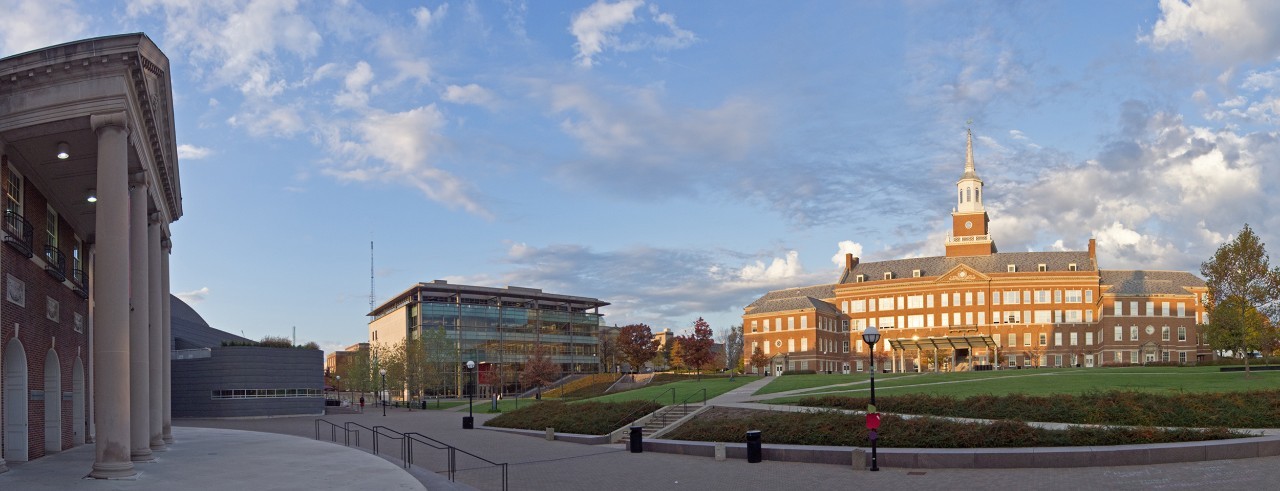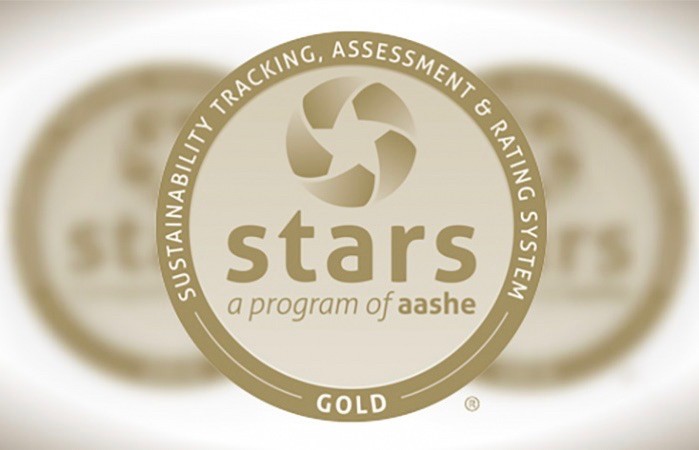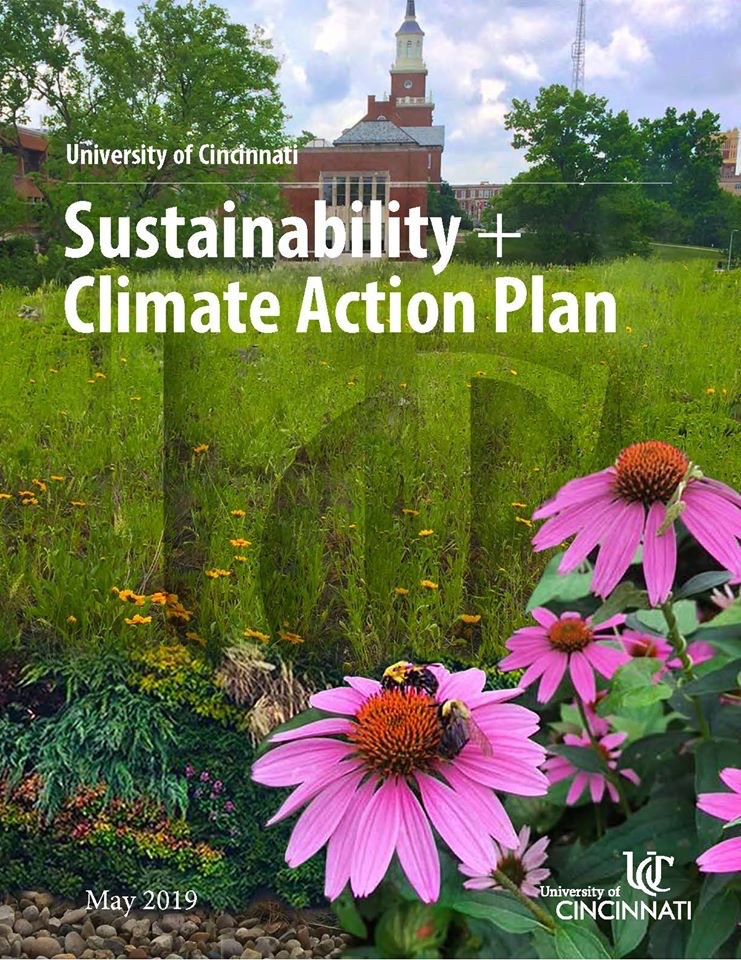
Gold-star campus stays green through carbon reduction
UC earns national recognition for reducing carbon footprint
Kicking coal. Green roofs. Living walls. LEED buildings. Through all these and more, the University of Cincinnati continually stays ahead of the sustainability curve, recently earning national recognition for its climate action and sustainability efforts.
“In the last 10 years we have reduced our carbon footprint by 28 percent through our diverse sustainability efforts on campus,” says Daniel Hart, sustainability coordinator for UC’s Department of Planning + Design + Construction. “In particular, we continue to build and renovate our buildings to Leadership in Energy and Environmental Design or LEED standards and we have stopped burning coal in our central utility plant.”
Since joining in on the “green” movement more than 13 years ago, UC has worked with the Sustainability Tracking, Assessment & Rating System called STARS as part of the Association for the Advancement of Sustainability in Higher Education (AASHE) — finally earning a gold STARS rating in 2017 — and aligning with the innovation agenda in the university’s strategic direction called Next Lives Here.

The collaboration between Second Nature and AASHE resulted in the Sustainability Tracking, Assessment & Rating System called STARS. Since 2017, UC has maintained gold-level campus STARS recognition.
For 27 years, the Second Nature program, which leverages higher education’s strengths to drive climate action, has worked with over 4,000 faculty and administrators at hundreds of colleges and universities to help make the principles of sustainability fundamental to every aspect of college education.
In 2007, UC made a formal committment after joining the American College & University Presidents’ Climate Commitment (ACUPCC) — a group of leaders motivated by their conviction that higher education had the capacity and responsibility to lead on climate and sustainability action for the sake of their students and society.
Since then, the ACUPCC has worked with Second Nature to become the lead supporting organization for recognizing higher ed institutions such as UC for their climate action innovation and excellence toward the goals of carbon neutrality.
For example, UC integrates interdisciplinary sustainability research into academic coursework and now has eleven LEED certified buildings and four currently tracking for certification — all supporting energy efficiency, sustainable site planning, regional issues of concern, life-cycle analysis, multi-modal transportation and innovative water efficiency.
This carbon footprint reduction is even more impressive when you consider that we have achieved this success while reducing our utility expenses by $5 million per year at the same time our enrollment has grown by 25 percent and our campus space has grown by 12 percent.
Joe Harrell associate vice president of UC Facilities Management

As part of the Sustainability + Climate Action Plan, UC continues to enhance renewable energy, a green built environment and works toward becoming completely carbon neutral by 2075.
As part of UC’s Sustainability and Climate Action Plan, Hart says the university agreed to track, report and reduce their carbon footprint toward the long-term pursuit of carbon neutrality by the year 2075 and published its first plan in 2009.
In 2019, the university published its robust 10-year updated plan revealing the progress it made in the last decade, as well as detailed plans for further reducing greenhouse gas emissions going forward.
“As stated in our climate action plan, we plan to have a net-zero carbon footprint by 2075,” says Hart. “Until then, we’re working with the Regional Cincinnati 2030 District about where we all, as a community, have agreed to collectively cut our emissions from transportation, water and energy by half before the year 2030. So we are well on our way to achieving our goals.”

UC's cogeneration plant produces the majority of the university's heat and power from natural gas fired turbines. Coal was replaced in 2010 with steam from UC's waste heat steam generators. In 2009 and 2010, the EPA's Combined Heat and Power Certification of Greenhouse Gas Reduction was awarded to UC's Utility Department for efficient operation of the cogeneration plant.
“It is very exciting that in the last decade we have made a very collaborative team effort with many departments within the university taking action to reduce our carbon footprint by such a large amount,” says Joe Harrell, associate vice president of UC Facilities Management. “This 28 percent carbon footprint reduction is even more impressive when you consider that we have achieved this success while reducing our utility expenses by $5 million per year at the same time our enrollment has grown by 25 percent and our campus space has grown by 12 percent.”
More than a year ago, UC Utilities, under the direction of Mike Hofmann, began purchasing renewable energy produced 100 percent by wind power generated within the Midwest for the university’s Clermont and Blue Ash regional campuses. But since the energy from those campuses isn’t coming from the central utility plant they aren’t included in this report.
“Being a part of the utilities team at the University of Cincinnati presents an opportunity to ‘make a difference’ to the world we live in,” says Hofmann. “UC Utilities has undertaken initiatives and projects which have successfully reduced annual carbon dioxide emissions by over 35,000 tons, and we continue to look for innovative ways to increase our contribution to the reduction of UC’s overall carbon footprint.”
Goals for making climate neutrality and sustainability a priority for UC include:
- Working with faculty to build on the number of sustainability and climate change-related courses
- Translating academic outcomes and theory into practice on campus
- Facilitating opportunities for the campus community to practice their innovative energy and climate-related solutions and ideas
- Increasing participation in the Office of Sustainability’s Environmental Literacy Certificate of Achievement program
- Automatic monitoring of heat, air and energy use in residence halls and buildings
“As UC continues to work alongside Second Nature and the President’s Climate Leadership Commitments, we will expand our ability to solve pressing sustainability challenges as we continue our carbon reduction efforts,” says Hart. “And through enhanced educational programs we envision our grads thriving through healthy, just and sustainable living within an actively changing world.”
Featured image at top: UC's campus around McMicken Commons. Photo/Jay Yocis/UC Creative + Brand
Impact Lives Here
The University of Cincinnati is leading public urban universities into a new era of innovation and impact. Our faculty, staff and students are saving lives, changing outcomes and bending the future in our city's direction. Next Lives Here.
Stay up on all UC's COVID-19 stories, read more #UCtheGood content, or take a UC virtual visit and begin picturing yourself at an institution that inspires incredible stories.
Related Stories
New platform connects biotech innovators with market opportunity
January 3, 2025
Exit Lab brought together leading biotech innovators focused on wearable biosensors to showcase their devices and help them either enter the market or license their technologies.
UC partners with Cincinnati Public Schools on $3.75M initiative
January 3, 2025
A partnership between the University of Cincinnati, Cincinnati Public Schools (CPS), Central State University in Ohio (CSU) and local mental health agencies has been formed to address the growing mental health needs of K-12 students in the region. The program is federally funded by a $3.75M grant from the Department of Education.
It’s a mindset: Meet the visionaries redefining innovation at...
December 20, 2024
Innovation is being redefined by enterprising individuals at UC’s 1819 Innovation Hub. Meet the forward thinkers crafting the future of innovation from the heart of Cincinnati.
